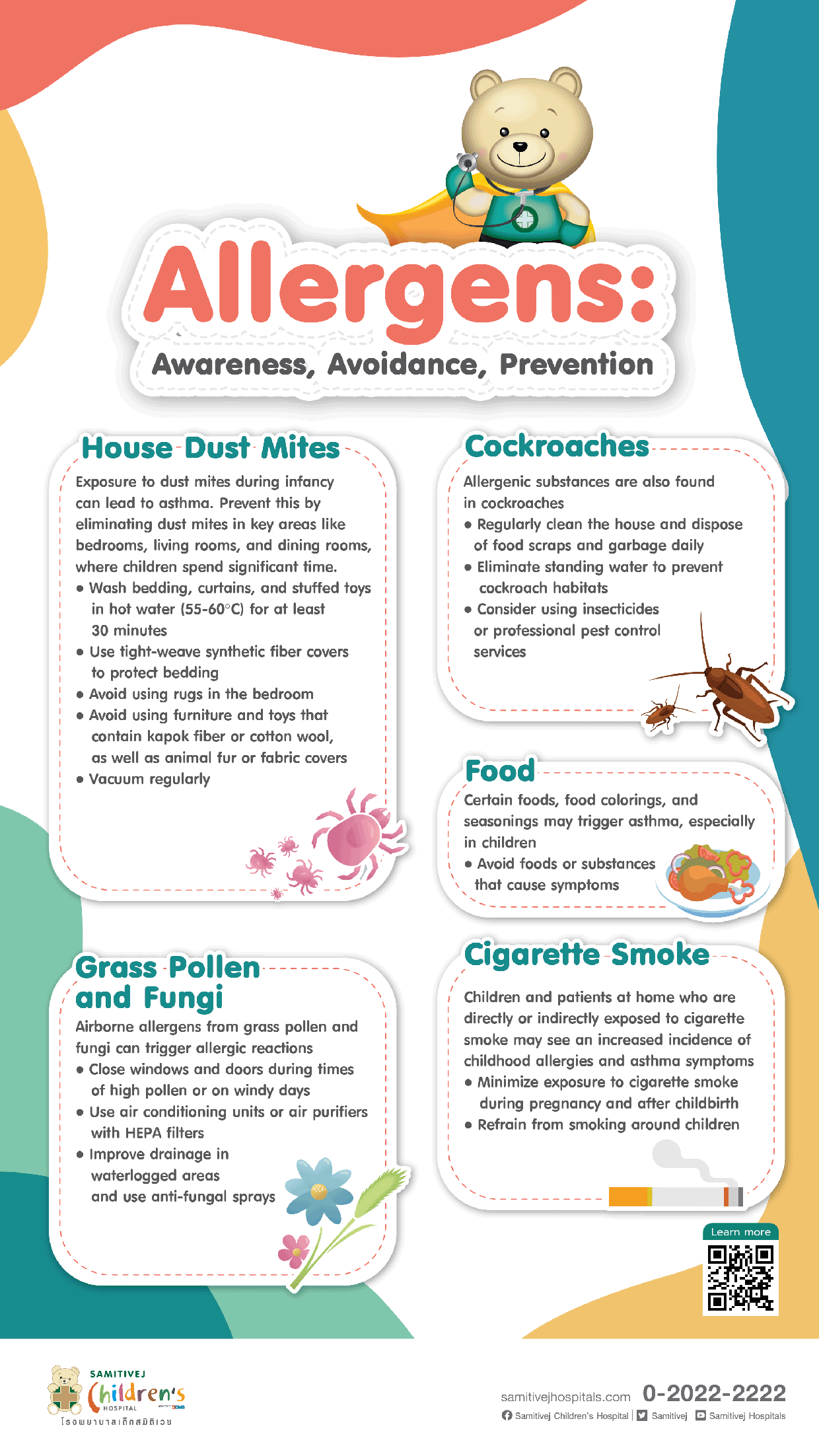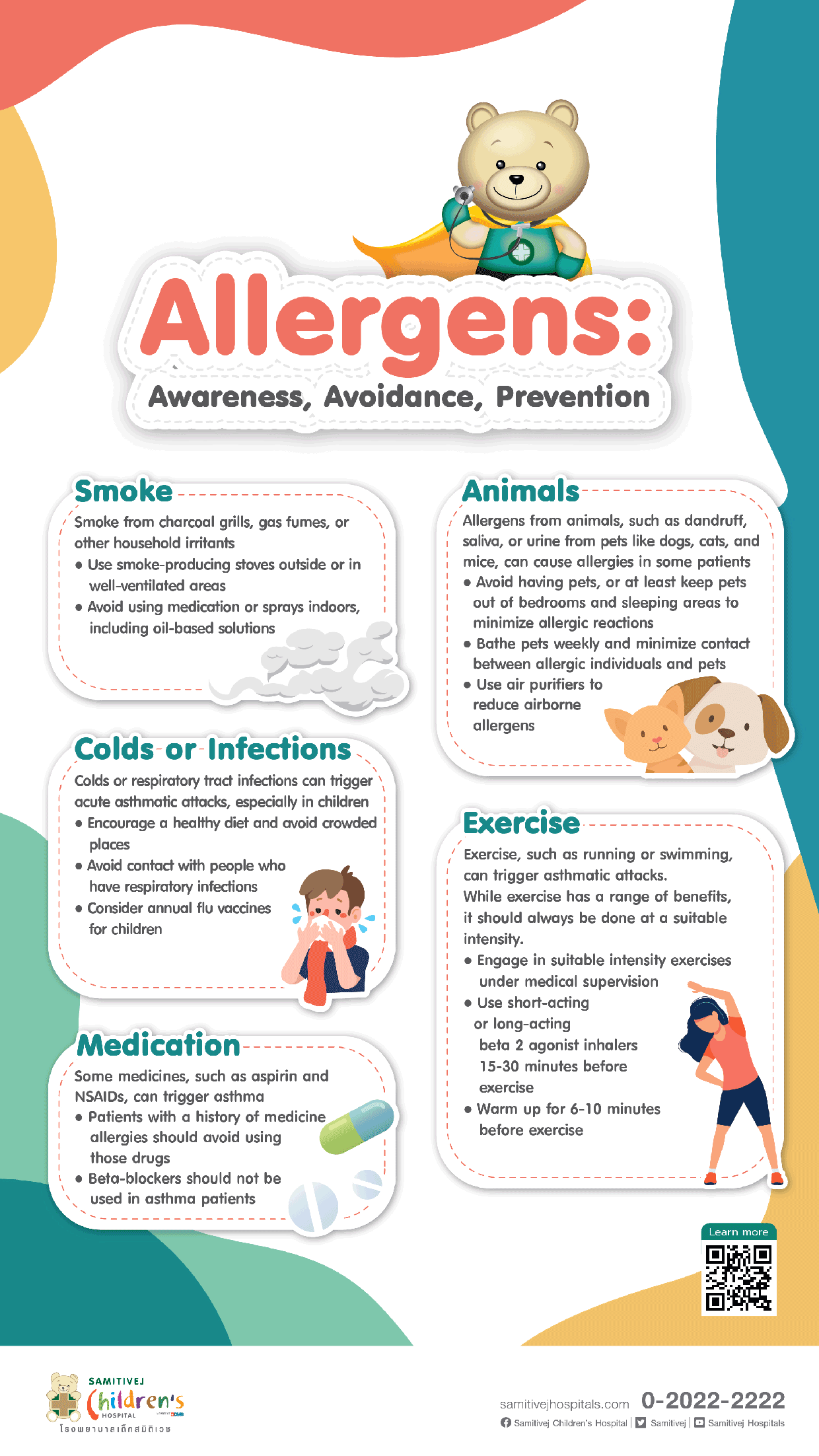What is an Allergy?
HIGHLIGHTS:
- In Thailand, the incidence of allergies has increased by 3-4 times when compared to 10 years ago, especially respiratory system allergies.
- The Skin Prick Test will find the exact cause of your allergies, and allow the doctor to plan the most effective treatment for you.
- In cases of respiratory system allergies caused by certain allergen substances that cannot be avoided, such as pollen, mold or dust mites, if the patient’s symptoms do not improve after other medications are taken, allergen immunotherapy may be necessary.
What is an Allergy?
An Allergy is an abnormal reaction by the body, which responds in an exaggerated way upon entering into contact with substances from the exterior, to which most other individuals do not normally react. These substances are called allergens. This includes:
- House dust mites
- dog and cat dander
- cockroaches
- pollen
The risk of developing allergies is increased if other family members suffer from allergies or asthma, for example, those with a parent or sibling with allergies.
Symptoms manifest themselves in allergic reactions affecting various organ systems throughout the body.
What Body Systems are Affected by Allergies?
Respiratory System Symptoms include runny nose, sneezing, nasal congestion (commonly known as hay fever), or may be accompanied by more severe symptoms, such as coughing and shortness of breath, which is also a symptom of asthma.
Most respiratory system allergies are caused by allergens in the air. In Thai people, the main cause is dust mites, followed by cockroaches, and the fur and dander of pets, such as cats and dogs, as well as plant pollen and mold in the air.
In some children, food allergies, such as to cow’s milk or eggs, may exhibit as symptoms of the respiratory system, such as wheezing and/or shortness of breath.
Skin These include hives (urticaria), eczema or allergic contact dermatitis. The main causes of hives are usually allergies to food and medications. Eczema usually occurs in children who have a family history of the allergy, and may be due to food allergies, such as to cow’s milk or eggs, causing a rash which normally occurs on the cheeks in small children or on the flexure area in older children.
Digestive System Symptoms include abdominal pain, vomiting, diarrhea and rectal bleeding, and are usually caused by food allergies.
Multiple Systems (Often accompanied by severe symptoms) Some patients have life threatening allergic reactions, with symptoms such as breathlessness or shortness of breath, hives, and the body going into shock, and these may even affect multiple organ systems. They may even be so severe as to cause death after eating certain foods, such as shrimp or peanuts, or after receiving medications such as penicillin.
How Common are Allergies?
The prevalence of allergic diseases are increasing worldwide, including in Thailand, where the incidence of allergies has increased by 3-4 times when compared to 10 years ago. The prevalence of allergic rhinitis is about 23-30 percent, asthma 10-15 percent, allergic eczema about 15 percent, and food allergies around 6 percent. Respiratory system allergies have increased in Thailand due to changes in the lifestyle of Thai people. The population has increased; cities are more crowded; houses have changed from being open, well-ventilated and airy to being more of the Western style with lower ceilings, filled with furniture and decor, windows closed at all times and air-conditioning used, carpeted rooms that gather dust, and plants and trees, which could gather mold, used as indoor decor. Indoor pets such as dogs and cats have also become more popular, with some people even sleeping with their pets. All of these things are possible allergens and are inhaled and/or touched continuously throughout the day, thus stimulating increased allergic reactions in people’s bodies.
In addition, there are also a variety of other factors, such as air pollution like sulfur dioxide, dusty roads, smoke and fumes from vehicle exhaust pipes and industrial factories, or even cigarette smoking. All of these are factors contributing to increased incidences of allergies today as well.
Causes of Allergies
- Genetics The risk of children developing allergies is increased if other family members have allergies, including asthma, allergic rhinitis or/and atopic dermatitis. If there is a family history of both parents having the allergy, there is an even higher chance than if only one parent is affected. That is, if either the father or the mother has an allergy, then there is about a 30-50 percent chance of the child having it as well. If, however, both parents have an allergy, the child’s chance of having the allergy is around 50-70 percent, while children from families with no history of allergy have only a 10 percent chance of developing the allergy.
- Environment This is a very important risk factor. These allergens enter our bodies via inhalation, consumption or touch. This includes:
- house dust mites
- dog and cat dander
- cockroaches
- pollen
- foods
- drugs


What Symptoms Could be Attributed to Allergies?
- Respiratory system allergies include symptoms of sneezing, itchy nose, runny nose, itchy eyes, scratchy throat, chronic coughing accompanied by phlegm, labored breathing or shortness of breath and wheezing breaths. These symptoms may come and go, may be seasonal, or may remain throughout almost the entire year, depending on the severity and the cause.
- Skin allergies may include symptoms of hives (urticaria), itchy rashes on foldable joints, or, in children, red rashes on cheeks.
- Digestive system allergies include symptoms of nausea, vomiting, diarrhea, abdominal pain and rectal bleeding.
- Multiple system allergies (anaphylaxis)—in patients with severe allergies, symptoms may include shortness of breath, difficulty breathing, hives, anaphylactic shock or even death.
Diagnosis of Allergies The doctor will start by making a thorough review of the patient’s medical history, and will carry out a physical health checkup and laboratory tests in certain patients. For patients who want to know what the cause of their allergy is, a skin test or blood testing may be carried out.
Skin Allergy Test
A skin allergy test or skin prick test is carried out to determine which allergens a patient is allergic to. For this test, the procedures are as follow
- the doctor will apply a drop of allergen extract on the patient’s arm or back
- a small lancet will be used to gently prick the extracts into the skin (small children who consent to the testing may be able to do so from 2 years and up)
- Results of the skin test can be read between 15-20 minutes after the test and, from these results, it can be determined what allergens a patient is allergic to.
* Patients must abstain from taking antihistamine or sleep medications for about 1 week before and leading up to the test, depending on the type of medication
* For patients who use steroids, the doctor should also be informed before testing is carried out.
Treatment of Allergies
Allergen Avoidance (if the patient knows what substances they are allergic to)
If you know what you are allergic to, try to avoid that substance as much as possible. Once the allergen is no longer entering the body, the symptoms will no longer appear. Some allergens are easily avoided. For example, avoiding pets can help the patient’s allergy symptoms to be reduced. Other allergens, however, are difficult to avoid, such as grass pollen, tree pollen or mold in the air, as these are present in the atmosphere and air we breathe, and thus are dependent upon environmental and seasonal factors. Certain allergens are difficult to avoid, but can be reduced, such as dust mites in beds, pillows and carpets. These can be reduced with persistent cleaning and regular vacuuming. Bed sheets and pillowcases should be cleaned frequently in hot water (about 60 degrees Celsius) and they should be washed at least once a week, as this will help reduce dust mites. You may also use dust mite-proof or allergen impermeable covers, which can help to significantly reduce the dust mites in beds that cause allergy symptoms. In cases of skin allergies due to contact with certain substances, such as rashes on the skin in areas that come into contact with jewelry or makeup, simply refraining from using said items will cause the allergy to stop.
Allergen Immunotherapy In cases of respiratory system allergies, such as allergic rhinitis and asthma, which are caused by allergies to certain allergen substances that cannot be avoided, such as pollen, mold or dust mites, and if the patient’s symptoms do not improve after other medications are taken, allergen immunotherapy may be necessary. This treatment method involves giving small doses of the substance, or allergen extract, to which the person is allergic, and gradually increasing the dosage over time to levels that can be controlled by the body. This type of therapy, however, is carried out over a long period of time. The first phase may involve weekly shots for over a period of 6 months, after which, shots may be given every 2 weeks, then every 3 weeks, and then every 4 weeks, respectively. This type of treatment can take from up to 3-6 years, gradually helping symptoms to decrease.
Prevention of Allergies
- Exclusive breastfeeding for the first four-six months of life. If the mother does not have enough breast milk or it is necessary to supplement the baby’s diet with other milk, using special baby milk formula may be helpful in preventing dermatitis in at-risk babies.
- Age-appropriate supplementary foods can be given to babies from the time they are 4-6 months and older, depending on the readiness of the baby, starting with the least allergenic foods, such as rice, green leafy vegetables, chicken and pork.
- Avoid the presence of allergens at home. In particular, babies’ bedrooms should be airy, clean, and free of clutter and unnecessary items. Beds and mattresses should be made of synthetic fibers, and wool should be avoided. Bed sheets, bed covers and pillowcases should be washed frequently and, if possible, should be washed in hot water. You should not have feather-stuffed dolls, carpets or books in babies’ rooms. Rooms should be wiped, mopped and cleaned regularly, and should be aired out and exposed to air and sunlight. Cigarette smoking should not be allowed in the house. Smoke and respiratory tract irritants should be avoided as much as possible. Additionally, try to avoid respiratory system infections, as certain viruses may result in children developing allergies more easily, or their symptoms worsening.